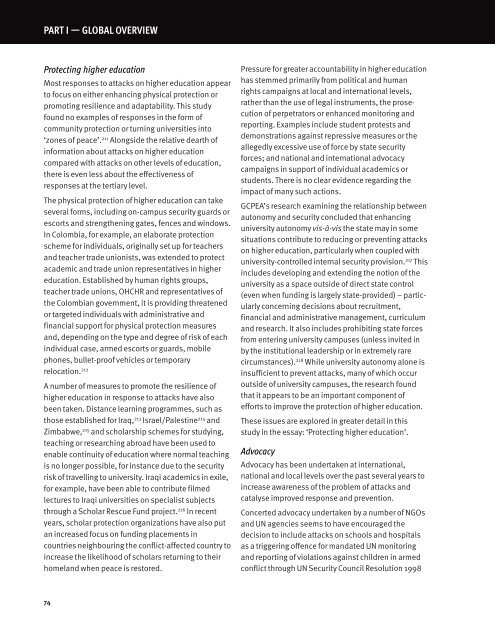You also want an ePaper? Increase the reach of your titles
YUMPU automatically turns print PDFs into web optimized ePapers that Google loves.
PART I — GLOBAL OveRvIeW<br />
Protecting higher education<br />
Most responses to attacks on higher education appear<br />
to focus on either enhancing physical protection or<br />
promoting resilience and adaptability. This study<br />
found no examples of responses in the form of<br />
community protection or turning universities into<br />
‘zones of peace’. 211 Alongside the relative dearth of<br />
information about attacks on higher education<br />
compared with attacks on other levels of education,<br />
there is even less about the effectiveness of<br />
responses at the tertiary level.<br />
The physical protection of higher education can take<br />
several forms, including on-campus security guards or<br />
escorts and strengthening gates, fences and windows.<br />
In Colombia, for example, an elaborate protection<br />
scheme for individuals, originally set up for teachers<br />
and teacher trade unionists, was extended to protect<br />
academic and trade union representatives in higher<br />
education. Established by human rights groups,<br />
teacher trade unions, OHCHR and representatives of<br />
the Colombian government, it is providing threatened<br />
or targeted individuals with administrative and<br />
financial support for physical protection measures<br />
and, depending on the type and degree of risk of each<br />
individual case, armed escorts or guards, mobile<br />
phones, bullet-proof vehicles or temporary<br />
relocation. 212<br />
A number of measures to promote the resilience of<br />
higher education in response to attacks have also<br />
been taken. Distance learning programmes, such as<br />
those established for Iraq, 213 Israel/Palestine 214 and<br />
Zimbabwe, 215 and scholarship schemes for studying,<br />
teaching or researching abroad have been used to<br />
enable continuity of education where normal teaching<br />
is no longer possible, for instance due to the security<br />
risk of travelling to university. Iraqi academics in exile,<br />
for example, have been able to contribute filmed<br />
lectures to Iraqi universities on specialist subjects<br />
through a Scholar Rescue Fund project. 216 In recent<br />
years, scholar protection organizations have also put<br />
an increased focus on funding placements in<br />
countries neighbouring the conflict-affected country to<br />
increase the likelihood of scholars returning to their<br />
homeland when peace is restored.<br />
Pressure for greater accountability in higher education<br />
has stemmed primarily from political and human<br />
rights campaigns at local and international levels,<br />
rather than the use of legal instruments, the prosecution<br />
of perpetrators or enhanced monitoring and<br />
reporting. Examples include student protests and<br />
demonstrations against repressive measures or the<br />
allegedly excessive use of force by state security<br />
forces; and national and international advocacy<br />
campaigns in support of individual academics or<br />
students. There is no clear evidence regarding the<br />
impact of many such actions.<br />
GCPEA’s research examining the relationship between<br />
autonomy and security concluded that enhancing<br />
university autonomy vis-à-vis the state may in some<br />
situations contribute to reducing or preventing attacks<br />
on higher education, particularly when coupled with<br />
university-controlled internal security provision. 217 This<br />
includes developing and extending the notion of the<br />
university as a space outside of direct state control<br />
(even when funding is largely state-provided) – particularly<br />
concerning decisions about recruitment,<br />
financial and administrative management, curriculum<br />
and research. It also includes prohibiting state forces<br />
from entering university campuses (unless invited in<br />
by the institutional leadership or in extremely rare<br />
circumstances). 218 While university autonomy alone is<br />
insufficient to prevent attacks, many of which occur<br />
outside of university campuses, the research found<br />
that it appears to be an important component of<br />
efforts to improve the protection of higher education.<br />
These issues are explored in greater detail in this<br />
study in the essay: ‘Protecting higher education’.<br />
Advocacy<br />
Advocacy has been undertaken at international,<br />
national and local levels over the past several years to<br />
increase awareness of the problem of attacks and<br />
catalyse improved response and prevention.<br />
Concerted advocacy undertaken by a number of NGOs<br />
and UN agencies seems to have encouraged the<br />
decision to include attacks on schools and hospitals<br />
as a triggering offence for mandated UN monitoring<br />
and reporting of violations against children in armed<br />
conflict through UN Security Council Resolution 1998<br />
74


